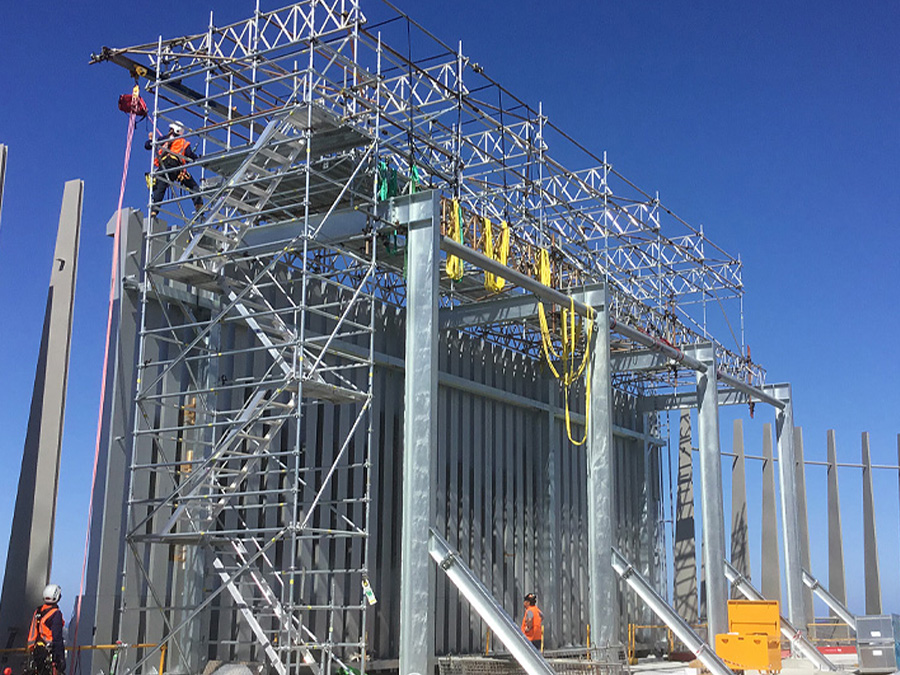Residential Scaffolding Solutions for Safe and Efficient Home Improvements
Residential Scaffolding Solutions for Safe and Efficient Home Improvements
Blog Article
Checking Out the Numerous Kinds Of Scaffolding Used in Construction Jobs
The construction industry counts heavily on numerous kinds of scaffolding to satisfy certain task needs, each offering distinctive benefits and applications. Traditional structure scaffolding gives a sturdy structure for basic jobs, while suspended scaffolding is crucial for job on skyscraper structures.

Standard Frame Scaffolding
Conventional structure scaffolding is just one of the most commonly made use of approaches in the building industry as a result of its effectiveness and convenience. This system includes horizontal and vertical frames that are set up to develop a secure system for workers and materials. The primary elements consist of upright blog posts, horizontal journals, and angled braces, which together supply a solid framework that can sustain considerable tons.
One of the essential benefits of standard frame scaffolding is its adaptability to various building projects, varying from residential structures to huge commercial frameworks. The modular layout permits easy assembly and disassembly, making it reliable for both temporary and long-lasting tasks. Furthermore, the system can be customized in elevation and width, fitting different building styles and site problems.
Safety and security is extremely important in scaffolding applications, and conventional framework systems are geared up with guardrails and toe boards to stop falls and make certain worker defense. Additionally, regular inspections and adherence to safety laws are vital in maintaining the honesty of the scaffold. Overall, typical framework scaffolding remains a basic option in the building and construction sector, providing a trustworthy platform for labor and improving total project performance

Suspended Scaffolding
Put on hold scaffolding offers a special remedy for building and construction jobs that require access to elevated surfaces, especially in situations where traditional frame scaffolding may be unwise. This type of scaffolding is typically put on hold from the roofing or upper levels of a structure, using a system of wheels, platforms, and ropes to develop a working space that can be adapted to various heights.
One of the main benefits of put on hold scaffolding is its adaptability. It can be conveniently repositioned or lowered to accommodate modifications in building demands, making it ideal for tasks such as window installation, façade job, and upkeep on skyscraper structures. In addition, the marginal impact of put on hold scaffolding enables for much better use of ground space in urban atmospheres, where room is typically minimal.
Security is a critical consideration in the use of put on hold scaffolding. Proper rigging and anchoring systems must be employed to ensure security and protect against crashes. Operators has to additionally be learnt the risk-free use of this equipment. Overall, suspended scaffolding provides a efficient and effective service for accessing hard-to-reach areas in numerous building and construction situations, improving both productivity and i thought about this safety and security on website.
System Scaffolding
System scaffolding, often considered a contemporary solution in the scaffolding sector, contains pre-engineered parts that can be swiftly assembled and adjusted for various building and construction jobs. Scaffolding. This kind of scaffolding is characterized by its modular layout, which permits flexibility and performance on work sites, suiting different elevations and architectural demands
Normally made from high-strength steel or light weight aluminum, system scaffolding offers boosted durability and security. The components consist of upright posts, horizontal journals, and angled braces, which adjoin safely, guaranteeing a durable framework. The design typically incorporates standard fittings, simplifying setting up and disassembly procedures, consequently reducing labor time and prices.

Rolling Scaffolding
Rolling scaffolding is a functional alternative to standard fixed scaffolding, created for wheelchair and simplicity of usage on building websites. This kind of scaffolding is composed of a system supported by frames with wheels, allowing employees to quickly move it as needed. The flexibility attribute considerably boosts efficiency, as it reduces downtime connected with assembling and disassembling dealt with scaffolding.
Typically constructed from lightweight materials such as light weight aluminum or steel, rolling scaffolding uses a tough yet mobile remedy for jobs needing constant repositioning - Scaffolding. It is particularly helpful in jobs such as paint, drywall installment, and electrical work, where access to numerous elevations and places is essential
Security is critical in rolling scaffolding style, with features such as locking wheels to stop unexpected motion when in operation, and guardrails to shield employees from falls. In addition, lots of models are adjustable in elevation, suiting various project needs.
Cantilever Scaffolding

The style of cantilever scaffolding generally entails making use of braces or arms secured to a building or framework, enabling the system to extend exterior safely. Safety and security is critical; hence, these scaffolds should be crafted to endure ecological problems and different lots. Regular assessment and upkeep are necessary to ensure structural honesty and worker security.
Cantilever scaffolding is preferred for its versatility and effective use space, making it a prominent selection scaffolder pay in urban atmospheres where room constraints prevail. It helps with much easier accessibility to high altitudes, ultimately contributing to the overall effectiveness of building and construction tasks. As with all scaffolding types, proper training and adherence to security requirements are essential for employees utilizing cantilever scaffolding.
Conclusion
Conventional frame scaffolding gives security, while suspended scaffolding offers convenience for raised tasks. System scaffolding promotes fast setting up, and rolling scaffolding improves wheelchair for varying job settings.
Typical frame scaffolding gives a tough foundation for basic jobs, while suspended scaffolding is crucial for job on high-rise frameworks.Rolling scaffolding is a flexible alternative to typical fixed scaffolding, designed for wheelchair and ease of usage on construction websites. As with all scaffolding types, appropriate training and adherence to safety criteria are vital for employees using cantilever scaffolding.
Traditional framework scaffolding provides stability, while put on hold scaffolding offers adaptability for raised tasks. System scaffolding promotes quick assembly, and rolling scaffolding boosts movement for differing job environments.
Report this page